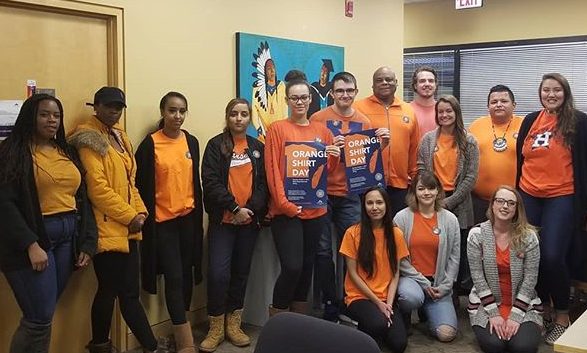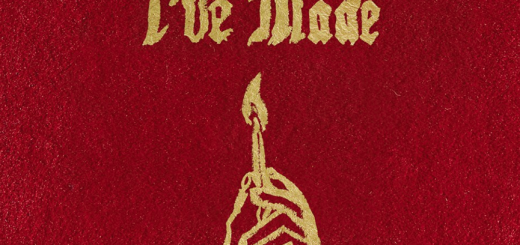Orange Shirt Day: “A piece of us has been missing for so long”
MRU community honours impacts of residential schools
By Sarah Ferguson, Contributor
On Oct. 1 Mount Royal University (MRU) honoured the survivors and lasting impacts of residential schools through Orange Shirt Day. The event included various activities across campus.

“Every Child Matters” pins were handed out at multiple MRU entrances in honour of Orange Shirt Day on Oct. 1. Photo by Nathan Woolridge
What is Orange Shirt Day?
On Orange Shirt Day, communities join together to remember residential schools and honour the journey of survivors and foster discussion about reconciliation. The day also honours the many children who never returned home
According to the Orange Shirt Day website, the concept behind the day came from Phyllis Webstad’s story. Webstad shares her story of having her new orange shirt taken away on her first day at the Mission school and the lasting effects this had throughout her life. The slogan “every child matters” was created by Webstad to show the commitment that everyone around us is valued.
Steve Kootenay-Jobin, Events and Housing coordinator at the Iniskim Centre, explained, “Our identities were impacted, but also a piece of us has been missing for so long. When children were brought away to residential schools it removed the concept of family and instead children were raised in institutions,” he says. “Having a day that honours this but also highlights Canada’s history is important because for too long our history and what was done to us as Indigenous peoples through Canada has been swept under the rug.”
Orange Shirt Day brings annual recognition to the harm the residential school system caused to children and families and ensures we are passing on the story and teaching future generations.
“I think it is important because we need to educate people. I interact with many students like myself who never had the opportunity to learn about Indigenous people,” says Kootenay-Jobin.
“We need an opportunity to be able to share our history and our impacts so that we can make sense of one another. There are also many Indigenous people who never had the opportunity to hear their stories, the stories of their families.”
The Sept. 30 date has significance because it is at the start of the school year, the time when children were taken from their homes to residential schools. It also provides an opportunity to discuss anti-racism and anti-bullying policies for the coming school year.

“Child Studies caption program wearing orange shirts to remember all children that went to residential school[s]…,” says the Iniskim Centre on Instagram. Photo courtesy of Iniskim Centre Instagram, @mru_iniskimcentre
How has Mount Royal Participated?
As Orange Shirt Day fell on a Sunday this year, the Mount Royal community wore orange shirt’s on Oct. 1. Everyone was invited to partake in this day.
The Iniskim Centre in collaboration with Professor Richard Foggo and one of his capstone courses (also known as a senior thesis) in Child Studies, the Education Undergraduate Student Society and the Child Studies Student Society, all wanted to bring awareness to honour the day.
Students greeted and handed out “every child matters” pins to the community at the main entrances of the university (East Gate, West Gate, Rec Entrance). In addition to the pins, there were also tables on Mainstreet set-up with pins, additional information about Orange Shirt Day and a video playing about Phyllis’ story.
An art installation in the T-wing courtyard called “Fallen Feathers” was on display, which is a set of tree carvings made by an Indigenous artist in the trees that were damaged during a heavy snowstorm in September 2014. This project was led by Carmela Amoroso, who is Sioux and Assiniboine and works in the university’s grounds department.
Kootenay-Jobin explained that “the reason the eagle feathers are upside down is because they’re meant to represent the children who were taken to residential schools but never returned home.” He goes on to say, “An eagle is a very significant animal among many Indigenous cultural groups across Canada, they represent purity and strength.
“Nothing flies above the eagle and many of our regalia but also spiritual tools all include eagle feathers. If one of them falls on the floor there is a ceremony that is meant to be done afterwards to cleanse it and to purify it again. For those children who never got to return home they never got to cleanse themselves and they never got that ceremony either and we’re still trying to heal from that.”
The carvings of falling eagle feathers honour residential school victims, survivors and their families. An Elder then performed a blessing as well as spoke about the importance of fallen feathers and the need for further discussion. There were drummers and a student performed a jingle dance.
“Drums are important to us because of the beat of our culture and the beat of our heart,” says Kootenay-Jobin. “We’ve chosen jingle dancing because the jingle dance is a healing dance and we want healing for all the families who were affected by residential schools and also for those who never got to return home.”
“… for too long our history and what was done to us as Indigenous peoples through Canada has been swept under the rug.”




